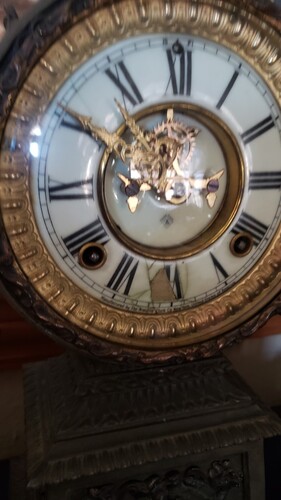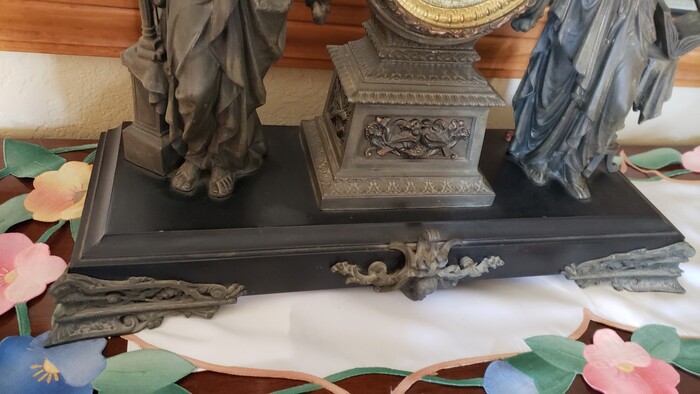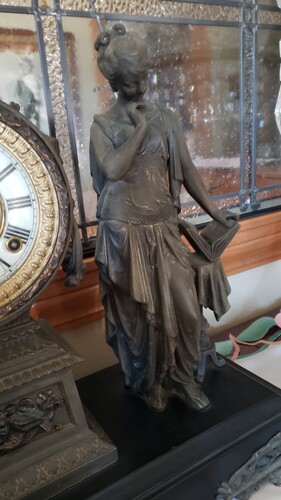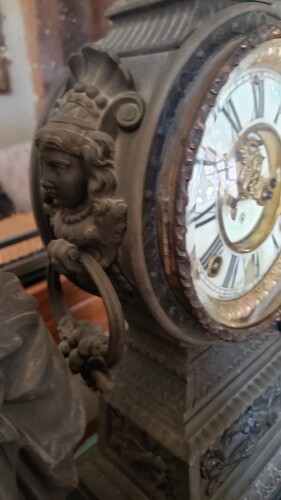Romeman type ladies on each side of clock, purchased unknown
UNKNOWN


Hello Mary Kay,
Thank you for sending in this Victorian era Spelterware figural mantel clock to mearto.com for an appraisal. I shall try to help you with that today.
TITLE:
Victorian, Dore bronze (gilt Spelterware), two train, dual spring, eight day time and striking figural mantel clock with outside or visible escapement, “Music and Poetry model, made by the Ansonia Clock Company, New York City, made circa 1894.
DESCRIPTION:
Case: 20.75” x 20.5” gilt spelter or Dore bronze dual figural mantel clock with a black marble (Belgian limestone rectilinear platform base) all resting on foliate cast spelter feet with a centrally attached rosette and floral metal ornament. The clock is set on a rectangular pedestal ornamented with a pair of doves and surrounding vines, all inset into the façade of the pedestal. Above is a tapered lance leaf ornamented pedestal neck which actually supports the canister type clock with the glazed dial bezel at the front and the clock surmounted by a rococo metal capped and handled urn (not shown). To either side of the clock are two female cast figures, the anthropomorphic representations of Poetry with her book on the right and her right hand at her chin in a thinking pose. Not shown, but on the left is a female figure of Music with her small harp tucked under her right arm with a neo-classical toga and sandal type shoes. (Of course, I have no way of knowing if either the urn finial atop the clock not part of the Music figure is broken since they are not shown in your photos. I will simply make the assumption that both are intact.) On the case sides are Dore bronze busts of young women in Nordic headdress with round pulls.
Dial: There is a glazed egg and dart brass dial bezel around this white enameled dial with Roman hour chapter ring, closed bar minute track, Brocot aperture @12 for making the movement run faster or slower from the dial side. There are rococo skeletonized gilt mid-18th century French-style hands.
The dial center is recessed and has a visible or outside escapement with the rotating escape-wheel and the pallets of the anchor recoil escapement. Just below is the logo of ‘A’ within a diamond shaped cameo, the logo of the Ansonia clock Company, also noted at the base of the dial, “Manufactured by the Ansonia Clock Co., new York City, United States of America.”
Movement: Not shown but would be a rectilinear fenestrated brass plate movement with four corner posts holding the two plates together with nuts and screws. The back plate should be engraved “Ansonia Clock Company, New York City”. There may be an Ansonia logo cast into the plate and a patent date circa 1881. This is a movement powered by two steel springs for eight days and striking on a coiled gong on the hour and half hour. The pendulum hangs from a knurled edge suspension which is adjustable for speed from the movement side.
CONDITION:
Case – Good condition. There are tiny remnants of the original gilding left on the case, but barely visible. So we are looking at a fully oxidized example of this type of clock which was original plated in “Japanese Bronze” or “silver”
Dial – Poor condition. Complex hairline fractures of the dial between the 29 and 34 minute markers with a large chip missing involving a good part of the hour no. six. The hands are replacements. The originals are thin steel Fleur-de-Lys hands. This dial damage impacts the price adversely and severely.
Movement – Could not be evaluated but will be assumed original, genuine and perhaps functional.
HISTORY:
ANSONIA CLOCK COMPANY HISTORY:
The Ansonia Clock Company’s roots lie in the Ansonia Brass Company, founded by Anson Greene Phelps in 1844. Phelps supplied brass to Connecticut clock manufacturers until 1851, when he joined forces with two powerful clockmakers, Theodore Terry and Franklin C. Andrews, to create a clockmaking company of his own. Terry and Andrews, who had a successful clockmaking business in Bristol, sold half of their business to Phelps in exchange for cheaper brass materials. Thus, the Ansonia Clock Company subsidiary was born.
Many Ansonia clocks are eight-day movements, meaning that they only need to be rewound every eight days. However, in 1875, the company developed a 30-hour, spring-driven illuminated alarm clock with a walnut veneer case. The alarm triggered a match to ignite a wick, which illuminated the clock. Ansonia’s extensive line of clocks included mantel clocks with elaborately painted china cases, beehive shelf clocks, miniature ogee shelf clocks with alarms, shelf clocks with glass domes surrounding the clock’s head, and regulator clocks like the 1886 "General" model, a brass 8-day, weight-driven clock with a cherry case and a dial that counted the seconds. Ansonia was also well-known for its novelty items, such as swinging clocks that featured sculpted figurines. In July 1853, Ansonia showcased its cast-iron clocks, painted and decorated with mother-of-pearl, at the New York World’s Fair. It was one of three Connecticut clockmaking companies to exhibit at the Fair. In the 1870s, the Ansonia Clock Company separated from the Ansonia Brass Company and moved part of its production to New York. Although the company continued to produce clocks in Connecticut, the New York factory, with clockmaker Henry J. Davies at the helm, employed more than twice as many workers—the majority of clocks produced from approximately 1880 on are marked "New York." The Ansonia Clock Company experienced disaster in 1880 when its New York factory caught fire, causing $750,000 in damages. However, the factory was rebuilt at the same location and reopened the following year. In 1883, the Connecticut factory closed, and by the late 1880s, Ansonia had opened sales offices in New York, London, and Chicago. Production peaked 1914, when Ansonia was turning out 440 different models of clocks, but by 1920, that number had dropped to less than 140, and by 1927, it was under 50. In 1929, Ansonia was sold to Amtorg Trading Corporation, the Soviet Union’s U.S. trading company, but in 1969, the rights to the Ansonia name and trademarks were acquired by Ansonia Clock Co., Inc. of Lynnwood, Washington.
COMPARABLES:
https://www.liveauctioneers.com/item/65881292_ansonia-figural-mantle-clock-music-and-poetry (SOLD, FOR $2100 IN 2018)
https://www.liveauctioneers.com/item/69130686_ansonia-figural-mantle-clock-music-and-poetry (SOLD FOR $500 IN 2019)
https://www.liveauctioneers.com/item/31430581_ansonia-double-figural-mantle-clock 9SOLD FOR $850 IN 2014)
https://www.barnebys.com/realized-prices/lot/ansonia-clock-co-ZGbZlGXTx8 9SOLD FOR $300 IN 2018)
https://www.barnebys.com/realized-prices/lot/an-ansonia-music-and-poetry-double-statue-clock-BYCcb9O9u (REACHED $350 IN 2018 AND WAS WITHDRAWN))
https://www.barnebys.com/realized-prices/lot/ansonia-figural-mantle-clock-music-and-poetry-FI4xgfkaDH (REACHED $800 IN 2018 AND WAS WITHDRAWN)
PRICING:
In very good condition with no breakage or damage and with a touch of the gold or silver plating remaining has a fair market value for $2000 today. Many of these cases have been regilded and today have a fair market value of $500 at auction.
With the damage to the dial on your clock and the loss of a finished surface, the fair market value drops to $175-$225 if sold as a unit. I add that comment because each of the figures by itself can sell for close to $150 each.
It would have been best to send in photos of all aspects of the clock rather than leaving out a statue and the upper finial over the clock and not showing the movement, since I cannot report much on what I cannot see. I hope you learned something about this item, which is a good seller in today’s market when there is no damage.
Thank you for choosing mearto.com.
My best,
David
Please log in to your Mearto account to contact this seller or make an offer on this item.



